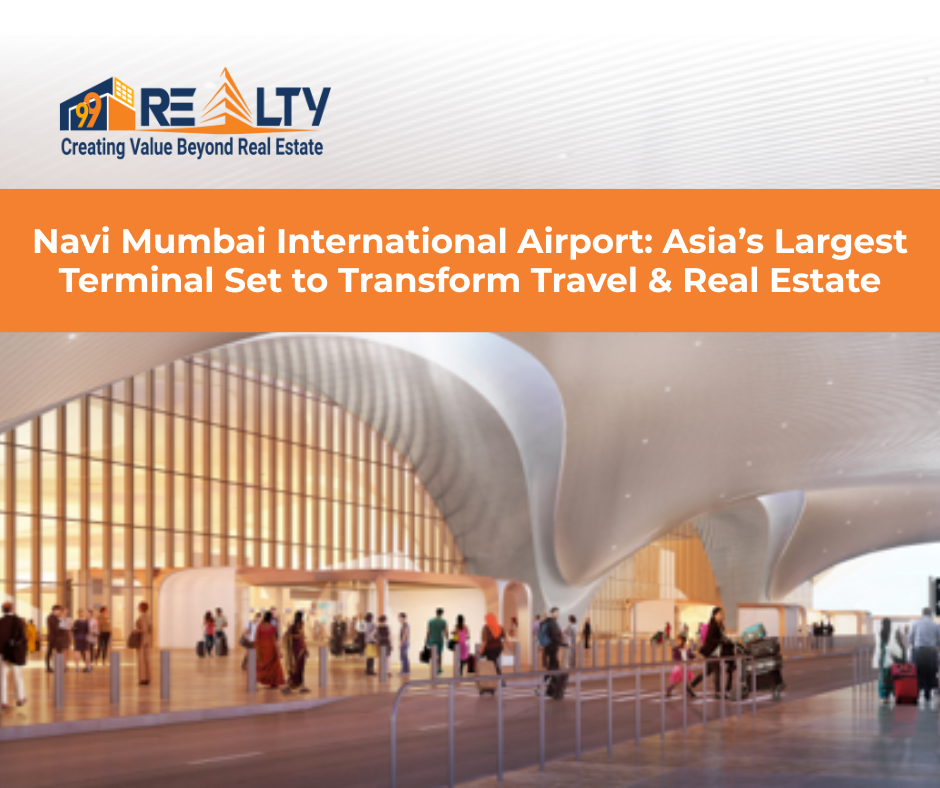Mumbai has long struggled with a single overburdened airport. Travelers know the chaos: packed lounges, endless queues, delayed flights. But this October 8, 2025, a new horizon opens — Navi Mumbai International Airport (NMIA). Officially inaugurated by Prime Minister Narendra Modi, NMIA promises not just a modern travel experience but a massive transformation in Maharashtra’s economy, urban landscape, and real estate markets.
Avoid These Real Estate Trap Zones in India Now
Mumbai’s Airport Dilemma
Overcrowding at CSMIA
Chhatrapati Shivaji Maharaj International Airport (CSMIA) handles more than 50 million passengers annually, often exceeding safe capacity. Expansion options are constrained by Mumbai’s dense urban fabric, making a second airport essential.
Planning NMIA: History & Stakeholders
The project is spearheaded by Navi Mumbai International Airport Limited (NMIAL), a joint venture between Adani Airports Holdings and CIDCO. The 1,160-hectare site in Ulwe, Panvel was chosen for proximity to Mumbai and room for future expansion. Work began in phases over a decade, overcoming land acquisition, environmental, and regulatory challenges.
Insider Tips for Land Owners in Joint Development
“NMIA will not only ease congestion at CSMIA but will also position Mumbai as a global aviation hub” says an NMIAL spokesperson.
What Makes NMIA Asia’s Biggest Airport?
Terminal Design & Capacity
Phase 1 opens with Terminal 1, handling 20 million passengers per year. Future phases (T2–T4) aim for 90 million passengers annually, rivaling world-class hubs like Dubai DXB and London Heathrow.
Lotus-Inspired Architecture
The terminal’s design is inspired by the lotus flower, symbolizing Indian culture while enabling efficient passenger flow. Interiors are designed for natural light, expansive lounges, retail zones, and landscaped atria.
Passenger Amenities & Technology
NMIA integrates high-tech facilities: biometric check-ins, automated baggage handling, digital signage, and airport apps for real-time updates. Lounges, food courts, and shopping spaces create a world-class experience.
Runways, Cargo & Air Traffic
The first 3,700-meter runway supports large aircraft, with a second runway planned. Cargo handling begins at 0.8 million tonnes annually, scaling with future expansions. This positions NMIA as a logistics and trade powerhouse for Maharashtra and India.
Sustainability & Green Initiatives
Solar power, rainwater harvesting, and energy-efficient lighting reduce the environmental footprint. Noise and pollution control measures ensure compliance with global aviation standards.
The October 8 Launch
Phases of Operation
While the ribbon-cutting happens in October, commercial operations are expected by December 2025. Initial flights will number 60 per day, scaling to 300 daily within six months.
Local Reactions & Naming
The airport is officially named Loknete D. B. Patil International Airport. Communities and politicians have debated the name, emphasizing local recognition alongside national prestige.
Economic Benefits of NMIA
Employment & Investments
Construction, aviation, logistics, and hospitality sectors will generate tens of thousands of jobs. The NAINA corridor around the airport is expected to attract billions in investment, fostering urban growth.
Trade & Cargo Growth
NMIA strengthens Mumbai’s role as an export-import hub. Faster air freight supports perishables, pharmaceuticals, and electronics, linking seamlessly with Mumbai’s ports and highways.
Enhanced National & Global Connectivity
Dual airports allow airlines to optimize traffic, introduce new international routes, and retain transit traffic within India.
How NMIA Will Transform Real Estate
Positive Impacts — Growth, Appreciation, Development
Nearby areas (Ulwe, Panvel, Kharghar) have already seen 20–30% price appreciation over three years. Developers are launching residential, commercial, and mixed-use projects. The airport acts as a catalyst for business parks, hotels, and logistics hubs.
Potential Risks — Speculation, Displacement, Infrastructure Gaps
Speculative price surges may outpace actual demand, leading to bubbles. Local infrastructure (water, roads, power) may lag development. Displacement and social pressures remain concerns.
Key Hotspots
| Area | Price Trend | Key Opportunity |
|---|---|---|
| Ulwe | ₹7,500 → ₹9,800/sq.ft | Ready-to-move projects |
| Panvel | ₹6,500 → ₹8,500/sq.ft | Mixed-use developments |
| Kharghar | ₹9,000 → ₹11,500/sq.ft | Luxury & mid-income housing |
Risks and Controversies
Environmental Concerns
Mangroves, wetlands, and local wildlife face disruption despite green initiatives.
Bird-Strike & Safety Risks
Illegal slaughterhouses within 3 km of the runway could attract birds, posing safety hazards. Authorities are inspecting and enforcing regulations.
Connectivity & Last-Mile Issues
Effective transport links — metro lines, coastal roads, highways — are critical. Delays could hinder airport utility.
Land Acquisition & Social Concerns
Compensation disputes, resettlement issues, and local grievances remain sensitive.
Lessons from Other Cities
Cities like London, Dubai, and Delhi show that multi-airport models succeed with:
- Integrated transport systems
- Differentiated airports (domestic vs international)
- Phased expansion without over-concentration
Mumbai’s NMIA follows these lessons but must prioritize connectivity and sustainable urban planning.
Long-Term Outlook
Expansion Phases
Terminals T2–T4 and a second runway will increase capacity to 90 million passengers per year by 2032.
Real Estate Growth & Urban Transformation
The airport zone may evolve into a second Mumbai, attracting tech parks, logistics hubs, and mixed-use urban centers. This can decongest central Mumbai and drive smart city development.
Conclusion
The Navi Mumbai International Airport is not just infrastructure; it is a catalyst for urban, economic, and real estate transformation. While challenges remain — environmental, social, or infrastructural — the airport positions Mumbai as a global aviation hub and creates unprecedented opportunities for residents, investors, and businesses. For Maharashtra, NMIA is a tangible leap into the future.
FAQs
When will commercial flights start at NMIA?
December 2025, after the initial inauguration in October.
Which areas will see maximum real estate growth?
Ulwe, Panvel, Kharghar, and JNPT corridor are prime candidates.
Is NMIA safe given environmental concerns?
Authorities are enforcing regulations for bird strikes, mangrove protection, and noise control.
Should investors buy property near NMIA now?
Early movers in ready-to-move or mixed-use projects may benefit, but avoid speculative or underdeveloped zones.
How does NMIA compare with other global airports?
NMIA is modeled on multi-airport cities like London, Dubai, and Delhi, emphasizing phased expansion, connectivity, and passenger experience.
Need Help?
Need help evaluating a property or planning your next move in the market?
Reach out to 99 REALTY – your trusted real estate partner for smarter choices.
Subscribe to get updates on our latest posts and market trends.






Join The Discussion